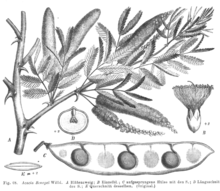The origin of gum arabic tree dates back to 4.000 years ago: the Egyptian artisans appreciated its sticky qualities, using it both as a binder for papyri pigments and as a thickener in cosmetics an for mummification.
Gum Arabic is a natural vegetal resin from in the famous "gum belt", that is the zone including different regions of Sudan; this resin is obtained from two different species of acacia growing in the' gum belt', or Sahel zone in South Sahara, which includes different regions of Sudan.
This resin is obtained through special tapping's made on the trunk of the Acacia Senegal tree (for alimentary sector, pharmaceutical industry and beverage) and Acacia Seyal (for oenological and biotechnological applications).
The resinous liquid which comes out of the tapping's to heal the cuts on the bark, thickens on contact with the air, forming a hard and glassy gum. This process is called "gummosis" and usually lasts from 3 to 8 weeks.
Acacia Senegal tree
The Gum Arabic in Sudan
Gum Arabic is the trade name for a natural forest product of the genus Acacia and is mainly obtained from Acacia Sengal commonly known as ( Hashab ).
The species has a wide distribution and remarkable adaptability. It is essentially a semi-arid zone species but, it so adaptable that it is not only drought resistant but also forest hardy.It can regenerate naturally from seeds or vegetatively from copies. The main area of its occurrence is the central part of Sudan where is species is uniform in pure stands giving Sudan the advantage of being the biggest producer and exporter of the best quality Gum Arabic, supplying 80% of the annual world requirements.
The species has a wide distribution and remarkable adaptability. It is essentially a semi-arid zone species but, it so adaptable that it is not only drought resistant but also forest hardy.It can regenerate naturally from seeds or vegetatively from copies. The main area of its occurrence is the central part of Sudan where is species is uniform in pure stands giving Sudan the advantage of being the biggest producer and exporter of the best quality Gum Arabic, supplying 80% of the annual world requirements.
Another important comparative advantages is that Sudan it occurs both wild and cultivated in wide area giving the advantages if economies of scale.
Historical Background:
Gum Arabic was known as an article of commerce since the year 400 B.C. and was widely used in Egypt during the Pharaoh 's Civilization in preparation of ink, water colours and dyes the name :GUM Arabic was derived from the fact that it was shipped to Europe from Arabian Ports in the old days. Gum Arabic is the therefore, long established in the world's Markets.
Gum Arabic was known as an article of commerce since the year 400 B.C. and was widely used in Egypt during the Pharaoh 's Civilization in preparation of ink, water colours and dyes the name :GUM Arabic was derived from the fact that it was shipped to Europe from Arabian Ports in the old days. Gum Arabic is the therefore, long established in the world's Markets.
Production
While gum arabic has been harvested in Arabia, Egypt, and West Asia since antiquity, sub-Saharan gum arabic has a long history as a prized export. The gum exported came from the band of Acacia trees which once covered much of the Sahel region: the southern littoral of the Sahara Desert running from the Atlantic to the Red Sea. Today the main populations of gum producing Acacia species are harvested in Mauritania, Senegal, Mali, Burkina Faso, Niger, Nigeria, Chad, Cameroon, Sudan, Eritrea, Somalia, Ethiopia, Kenya and Tanzania. Acacia senegal is tapped for gum by cutting holes in the bark, from which a product called Kordofan or Senegal gum is exuded. Seyal gum, from Acacia seyal, the species more prevalent in East Africa, is collected from naturally occurring extrusions on the bark. Traditionally harvested by semi-nomadic desert pastoralists in the course of their transhumance cycle, gum arabic remains a main export of several African nations, including Mauritania, Niger, Chad, and Sudan. The hardened extrusions are collected in the middle of the rainy season (harvesting usually begins in July), and exported at the start of the dry season (November). Retrieved 2008-07-10.</ref> Total world gum arabic exports are today (2008) estimated at 60,000 tonnes, having recovered from 1987–1989 and 2003–2005 crises caused by the destruction of trees by Desert locust.Sudan, Chad, and Nigeria, which in 2007 together produced 95 percent of world exports, have been in discussions to create a producers' cartel.
Acacia seyal from Paul Hermann Wilhelm
Aubert's Leguminosae. in Engelmann
(ed.): Natürliche Pflanzenfamilien. Vol. III, 3., 1891
Acacia seyal from Paul Hermann Wilhelm
Taubert's Leguminosae. in Engelmann
(ed.): Natürliche Pflanzenfamilien. Vol. III, 3., 1891




No comments:
Post a Comment